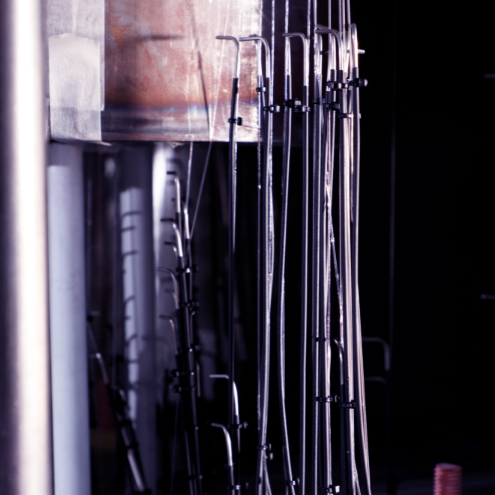
3
Reactor structures and components
IRESNE studies nuclear technologies that can operate in a sodium-cooled fast reactor environment.
Its experts also focus their research on reactor structures and components, which must be able to withstand numerous interactions between themselves and other components in the reactor while in service. They must be robust and resistant to the hostile environment in which they are placed. The technologies involved in this type of reactor must take into account new properties, particularly those due to the use of sodium as the coolant.
The institute investigates the feasibility of innovative components and develops instrumentation capable of inspecting structures when immersed in sodium.
-
Magnetohydrodynamic pumps:
Our researchers study magneto-hydrodynamic pump concepts that are compatible with the properties of the metal sodium coolant. These pumps are designed to move the conducting coolant by means of a combined electric and magnetic field. A demonstration pump called PEMDYN was fully designed and tested by our teams on the experimental platform developed to investigate liquid metals.
-
Heat exchangers:
Heat exchangers have also been investigated by our scientists. As sodium reacts chemically with water, the steam generator driving the turbogenerator will probably be replaced by a gas conversion system. In this case, the heat from the secondary sodium system is transferred to nitrogen, which under pressure then expands in the turbines, powering them to produce electricity. Sodium-gas heat exchangers represent a veritable breakthrough in this power conversion system, but numerous obstacles must still be overcome, particularly in terms of efficiency.
-
Cold traps:
Cold traps are components specific to SFRs; they are designed to purify liquid sodium through the crystallisation of sodium oxide (Na2O) of sodium hydroxide (NaH). This continuous filtration is needed to remove the impurities that exist in the liquid sodium at the start of reactor operation. These impurities become activated when the sodium flows through the reactor core, thus making the sodium radioactive and therefore rendering maintenance and dismantling operations very complicated. This purification process has undeniable advantages, being very efficient and boasting a high retention capacity. By purifying the sodium, it retains its excellent core cooling properties.
-
Effective and robust instrumentation in sodium:
- Measuring the gas quality in the gas-cover plenum.
Feedback collected from experimental reactors has shown that it is important to monitor the quality of the cover gas in the plenum. For this reason, IRESNE is developing instrumentation capable of accurately measuring the composition of the elements having accumulated in the top part of the reactor, which is an extremely hostile environment. This instrumentation therefore helps ensure reactor safety.
- Performing measurements in sodium.
Our experts design clever, innovative solutions to adapt to the specific properties of sodium, e.g. opacity, high temperatures nearing 550°C during operation and 200°C at shutdown. As sodium carries sound well, acoustic instrumentation provides a good way of monitoring the appearance of off-normal conditions during reactor operation (presence of bubbles, sodium boiling, cavitation in the mechanical pumps, gas or water leaks, impacts from migrating objects, mechanical failures, etc.) and of checking the good condition of the reactor structures during shutdown. This instrumentation also makes it possible to identify components or fuel assemblies that require handling.
- Detecting sodium leaks.
Sodium leaks can have significant consequences on reactor safety. This is why the teams at IRESNE design new devices and enhance patented methods to detect sodium leaks. These new methods specifically aim to significantly reduce the time needed to detect any leaks.
-
Experimentation to improve fourth-generation reactor structures and components:
Research on SFR structures and components are made possible through experimental validation using our liquid metal testing platform called PAPIRUS. This platform is used to test new technologies intended for fourth-generation reactor designs. Experiments on simulating fluids are also conducted to qualify computer codes whenever this is possible; for instance, water is a good simulating fluid to characterise flows.